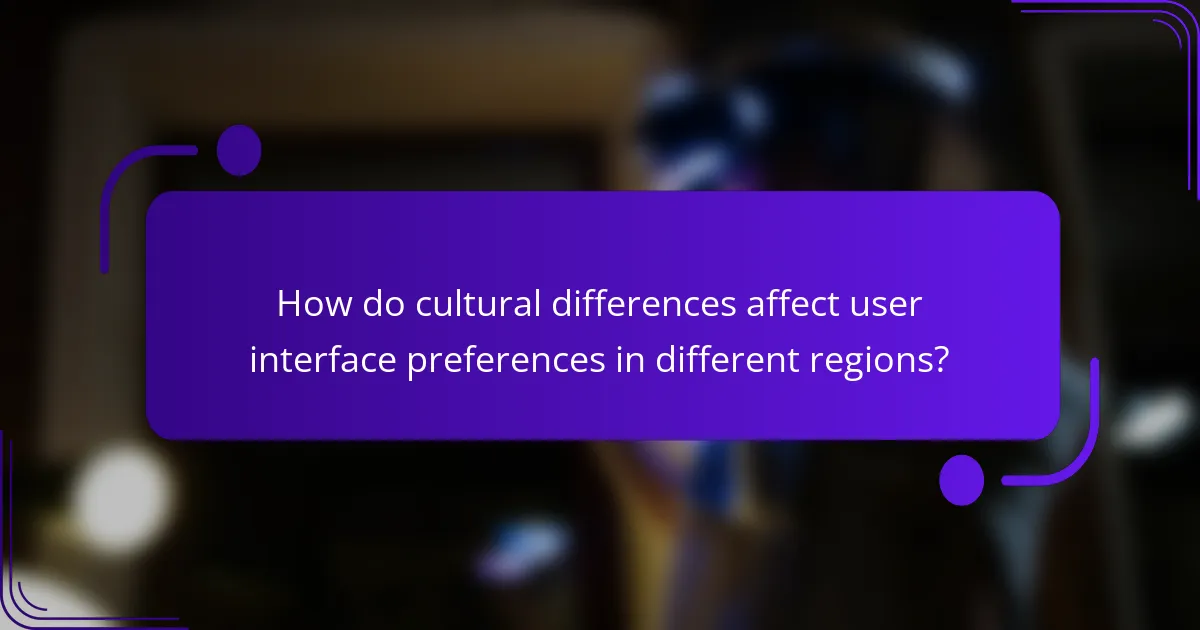Effective user interface design in multiplayer fantasy adventure games enhances player engagement and satisfaction. Key considerations include intuitive navigation, responsive feedback, and immersive visuals. Cultural preferences impact design choices, while emerging features like voice-activated controls and adaptive UI elements are shaping future gameplay. Integrating user feedback throughout the design process ensures a user-centered approach that meets evolving player expectations.

What are the key principles of user interface design in multiplayer fantasy adventure games?
Effective user interface design in multiplayer fantasy adventure games focuses on accessibility, clarity, and engagement. Key principles include intuitive navigation, responsive feedback, and immersive visuals.
Intuitive navigation ensures players can easily access game features and understand controls. Responsive feedback provides immediate reactions to player actions, enhancing engagement. Immersive visuals create a captivating atmosphere that aligns with the game’s theme, making the user experience more enjoyable.
Additionally, incorporating customizable interfaces allows players to tailor their experience, fostering a sense of ownership. Clear communication of in-game information, such as health stats and inventory, is crucial for informed decision-making during gameplay.
How does user experience influence player engagement in these games?
User experience significantly enhances player engagement in multiplayer fantasy adventure games. A well-designed user interface fosters intuitive navigation, making it easier for players to immerse themselves in the game world.
Clear visual hierarchies and responsive controls contribute to a seamless experience, reducing frustration and maintaining player interest. Engaging elements like dynamic feedback and personalised options can also elevate emotional investment, encouraging players to explore more deeply.
Additionally, social features such as chat systems and cooperative tasks enhance community interaction, further boosting engagement. Overall, an effective user interface design directly correlates with sustained player involvement and satisfaction.
Which design elements are essential for effective navigation?
Effective navigation in multiplayer fantasy adventure games relies on clear visual hierarchy, intuitive layout, responsive design, and consistent labeling. These elements ensure players can easily access game features and information.
Visual hierarchy guides players’ attention to essential elements, helping them navigate menus and interfaces efficiently. Intuitive layout organizes content logically, allowing for quick recognition of functions. Responsive design adapts to various devices, enhancing user experience across platforms. Consistent labeling provides clarity, reducing confusion during gameplay.
What role does visual hierarchy play in gameplay?
Visual hierarchy significantly enhances gameplay by guiding player focus and improving decision-making. It organizes information, making vital elements stand out while minimizing distractions. Effective visual hierarchy fosters a seamless user experience, allowing players to navigate complex environments intuitively. This design principle ensures that essential gameplay mechanics, such as health indicators and objectives, are easily identifiable, thereby enhancing engagement and strategic planning.

How do cultural differences affect user interface preferences in different regions?
Cultural differences significantly influence user interface preferences in multiplayer fantasy adventure games. For example, Western players often favour straightforward navigation and minimalistic design, while Eastern players may prefer rich visuals and complex interfaces. Regional colour associations also play a role; red signifies luck in some cultures but danger in others. Understanding these preferences enhances user engagement and satisfaction across diverse markets.
What are the common UI design trends in North American multiplayer fantasy games?
Common UI design trends in North American multiplayer fantasy games include immersive visuals, vibrant colour palettes, and intuitive navigation. These games often prioritise user engagement through dynamic interfaces and responsive design elements. Minimalistic layouts enhance clarity, while thematic elements reinforce the fantasy setting. Additionally, customizable HUDs allow players to tailor their experience, emphasizing personalisation in gameplay.
How does the Japanese gaming culture shape user interface design choices?
Japanese gaming culture significantly influences user interface design choices in multiplayer fantasy adventure games by emphasizing aesthetics, user engagement, and cultural storytelling.
The integration of vibrant visuals and intricate designs reflects Japan’s artistic heritage, enhancing user immersion. Additionally, user interfaces often prioritise intuitive navigation, catering to diverse player demographics.
Cultural elements, such as character customisation and narrative depth, shape how interfaces present information, making them more relatable to players. This unique approach fosters a strong connection between the game and its audience, ultimately enhancing the overall gaming experience.
As a result, user interface design in these games becomes a blend of tradition and innovation, showcasing Japan’s unique gaming identity.

What are the unique challenges faced in designing interfaces for multiplayer settings?
Designing interfaces for multiplayer settings presents unique challenges that require careful consideration. These challenges include balancing individual player experiences with group dynamics, ensuring clear communication, and managing screen real estate effectively.
In multiplayer fantasy adventure games, the interface must support real-time interactions among players while providing essential information without overwhelming them. Unique attributes such as customizable HUD elements can enhance user experience, allowing players to prioritise relevant data.
Additionally, rare attributes like adaptive UI that changes based on player roles can improve usability. As a result, designers must create flexible interfaces that accommodate diverse gameplay styles and preferences, ensuring an engaging and cohesive experience for all players.
How can designers balance complexity and usability in multiplayer environments?
Designers can balance complexity and usability in multiplayer environments by prioritising intuitive interfaces. Focus on clear visual hierarchies, consistent controls, and contextual tutorials to guide players. Incorporate user feedback to refine designs, ensuring they meet diverse player needs. Employ adaptive systems that adjust complexity based on player skill levels, enhancing engagement without overwhelming users.
What strategies can be employed to facilitate communication among players?
Effective strategies to facilitate communication among players include implementing voice chat features, providing customizable text chat options, and integrating emotes or quick commands. These tools enhance player interaction, fostering teamwork and engagement during gameplay. Additionally, tutorials on communication features can improve usability and encourage players to utilise these systems effectively.

Which innovative user interface features are emerging in 2025?
Emerging user interface features in 2025 for multiplayer fantasy adventure games include voice-activated controls, adaptive UI elements, augmented reality overlays, and AI-driven NPC interactions. These innovations enhance player immersion and engagement.
Voice-activated controls enable players to issue commands without manual input, streamlining gameplay. Adaptive UI elements adjust based on player behaviour, providing a personalised experience. Augmented reality overlays integrate real-world elements into the game, enriching the fantasy environment. AI-driven NPC interactions create dynamic storytelling, making each player’s experience unique.
These features represent a shift towards more intuitive and immersive gameplay, aligning with player expectations for advanced technology in gaming.
How do adaptive interfaces enhance user experience in multiplayer games?
Adaptive interfaces significantly enhance user experience in multiplayer games by personalising interactions and streamlining gameplay. They adjust in real-time to player behaviour, preferences, and skill levels, creating a more engaging environment. For instance, dynamic HUD elements can display relevant information based on the player’s current context, improving decision-making. Additionally, adaptive controls can simplify complex actions, making the game more accessible to new players while still offering depth for veterans. This tailored experience fosters a sense of immersion and satisfaction, ultimately leading to increased player retention and enjoyment.
What role does augmented reality play in modern game UI design?
Augmented reality enhances user interface design in multiplayer fantasy adventure games by creating immersive experiences. It allows players to interact with the game world through real-world elements, enriching visual storytelling. This technology integrates game mechanics seamlessly, improving navigation and engagement. For example, AR can display quest markers or character stats directly in the player’s field of view, making gameplay more intuitive. Additionally, AR fosters social interaction by enabling players to share experiences in real-time, enhancing the multiplayer aspect of these games.

How can user feedback be effectively integrated into UI design processes?
User feedback can be effectively integrated into UI design processes by prioritising user input throughout development. Engaging players during early testing phases helps identify pain points and preferences. Regular updates based on feedback ensure the interface evolves with user expectations.
Collecting feedback through surveys and playtests allows designers to gather actionable insights. Analyzing player behaviour data reveals trends that inform design choices. Iterative design cycles enable continuous improvement, ensuring the UI remains intuitive and engaging.
Incorporating user feedback fosters a sense of community and ownership among players. This approach enhances overall satisfaction and can lead to increased player retention. Ultimately, integrating feedback creates a user-centered design that aligns with the goals of multiplayer fantasy adventure games.
What methodologies are best for gathering player insights on interface usability?
User testing, surveys, and analytics are effective methodologies for gathering player insights on interface usability in multiplayer fantasy adventure games. These methods provide direct feedback, quantify user interactions, and identify areas for improvement.
User testing involves observing players as they navigate the interface, revealing usability issues and preferences. Surveys can capture player opinions and satisfaction levels, providing quantitative data on user experience. Analytics tools track player behaviour, offering insights into navigation patterns and feature usage.
Combining these methodologies enhances understanding of player needs and fosters iterative design improvements. Engaging diverse player demographics ensures comprehensive insights, tailoring the interface to varied user preferences.
How can iterative design improve player satisfaction over time?
Iterative design enhances player satisfaction by continuously refining user interfaces based on feedback. This process allows developers to identify pain points and improve gameplay experiences over time. Regular updates can introduce new features, streamline navigation, and enhance visual appeal, creating a more engaging environment for players. As a result, players feel more valued and invested in the game.

What best practices should designers follow for optimizing user interfaces?
Designers should prioritise usability, consistency, and accessibility in user interface design for multiplayer fantasy adventure games. Effective UI enhances player experience and engagement.
1. Maintain a consistent visual language across menus, icons, and gameplay elements to foster familiarity.
2. Optimize navigation by ensuring intuitive pathways for players to access features and information quickly.
3. Implement responsive design to accommodate various devices and screen sizes, enhancing accessibility.
4. Utilize feedback mechanisms, such as animations or sounds, to inform players of their actions and system responses.
5. Conduct user testing to gather insights on player interactions and refine the interface based on real-world usage.
Which common mistakes should be avoided in multiplayer game UI design?
To enhance multiplayer game UI design, avoid common mistakes like cluttered screens, inconsistent navigation, poor readability, and neglecting player feedback. These issues can hinder user experience and engagement.
1. Cluttered Interfaces: Overloading screens with too many elements can confuse players.
2. Inconsistent Navigation: Using different layouts or controls can disorient users.
3. Poor Readability: Small fonts or low contrast make text difficult to read.
4. Ignoring Player Feedback: Failing to incorporate user suggestions can lead to frustration.
5. Lack of Accessibility: Not considering diverse player needs limits your audience.
6. Overcomplicated Tutorials: Lengthy or unclear tutorials can deter new players.
Addressing these mistakes fosters a more intuitive and enjoyable gaming experience.
What expert tips can enhance the effectiveness of game interfaces?
To enhance the effectiveness of game interfaces in multiplayer fantasy adventure games, focus on intuitive design, responsive controls, and clear feedback mechanisms. Prioritise user experience by simplifying navigation and ensuring accessibility for all players.
1. Conduct user testing to gather feedback on interface usability.
2. Implement visual hierarchy to guide players’ attention effectively.
3. Use consistent iconography to reduce cognitive load.
4. Ensure customisation options to cater to diverse player preferences.
5. Integrate tutorial elements for onboarding new players.
6. Optimize performance to minimize lag during gameplay.